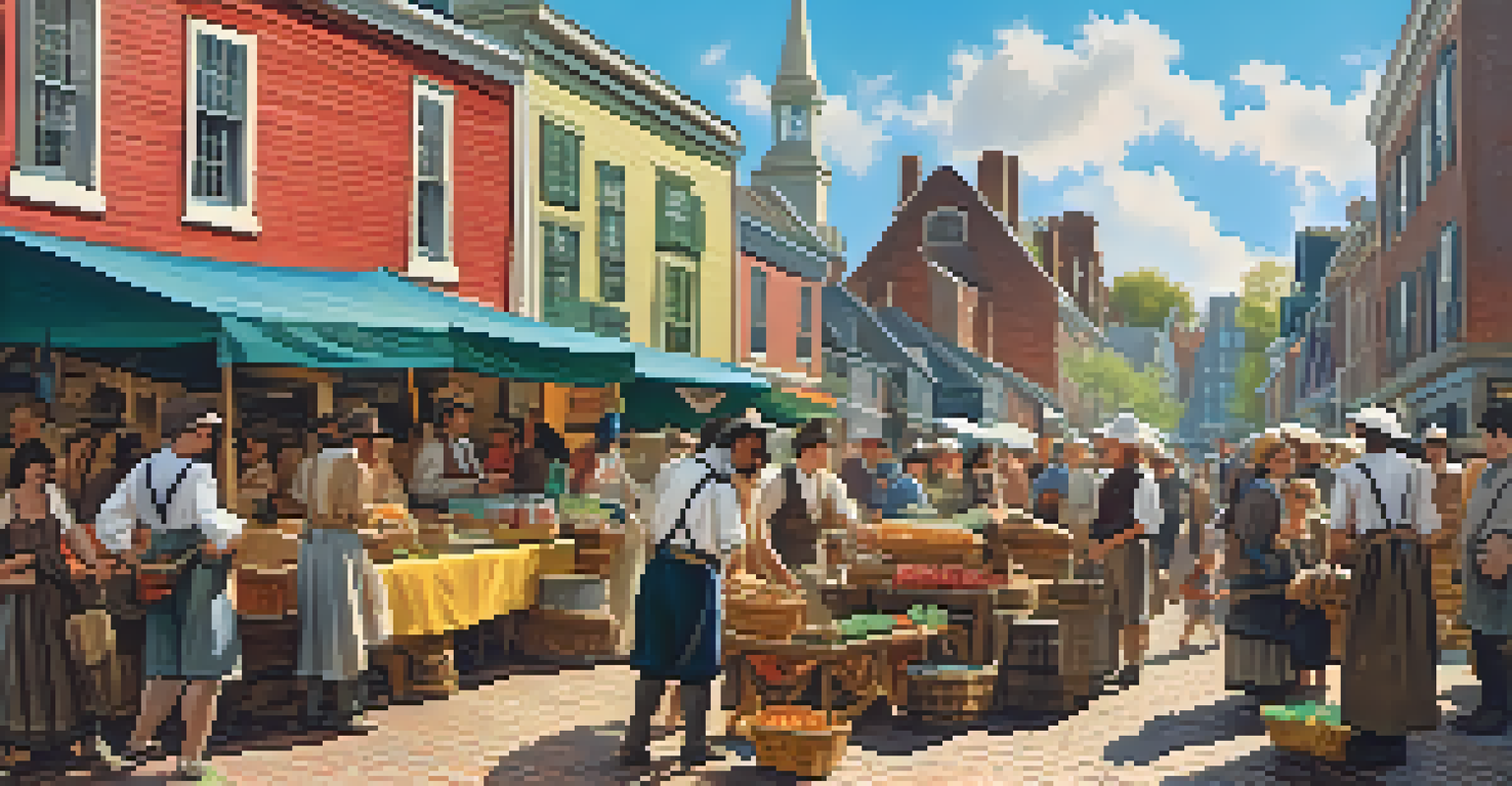The Rise of Boston's Maritime Trade in the 18th Century

The Early Beginnings of Boston's Maritime Trade
Boston's maritime trade began to take shape in the early 17th century, as the city's location on the Atlantic coast made it a natural harbor. The Puritans who settled in the area recognized the potential for trade, establishing connections with Europe and the Caribbean. Their small fishing and trading vessels slowly evolved into larger ships capable of carrying goods across the ocean, paving the way for a bustling trade economy.
The sea, once it casts its spell, holds one in its net of wonder forever.
By the 18th century, the city had become a key player in transatlantic trade, exporting local goods like fish, timber, and rum. The growing demand for these products, especially in Europe, encouraged shipbuilding and the employment of skilled laborers in Boston. This burgeoning industry not only boosted the economy but also laid the groundwork for a vibrant maritime culture.
As trade routes expanded, so did Boston's reputation as a commercial hub. The port became a lively center of activity, attracting merchants, sailors, and traders from various regions. The interplay of local resources and international markets illustrated the city's integral role in America's economic landscape.
Key Goods Traded Through Boston's Ports
The 18th century saw a diverse range of goods being traded through Boston, significantly shaping its economy. Notably, the city became famous for its rum, made from molasses imported from the Caribbean. This not only satisfied local demand but also fueled the triangular trade route, linking New England, Africa, and the West Indies in a complex web of commerce.

In addition to rum, Boston exported fish, particularly cod, which was a staple for both local and international markets. Fishermen would venture out into the Atlantic, bringing back bountiful catches that found their way into markets across Europe. The fish trade was so vital that it created a network of support industries, from shipbuilding to curing and processing.
Boston's Maritime Trade Origins
Boston's maritime trade began in the early 17th century as Puritan settlers leveraged the city's Atlantic harbor to establish connections with Europe and the Caribbean.
Timber was another crucial commodity, as the lush forests of New England provided the necessary resources for shipbuilding and construction. This connection between local agriculture and maritime trade allowed Boston to thrive economically, ensuring a steady flow of goods and services that supported the city’s growth.
The Role of Shipbuilding in Maritime Trade
Shipbuilding emerged as a cornerstone of Boston's maritime trade in the 18th century, driven by the increasing demand for vessels. Local craftsmen, skilled in the art of shipbuilding, began constructing larger and more durable ships that could withstand long ocean voyages. This innovation not only improved trade efficiency but also created jobs for numerous artisans and laborers in the region.
In every outthrust headland, in every curving bay, in every grain of sand there is the story of the earth.
The design and construction of ships became a community effort, with various tradespeople contributing to the process. Carpenters, blacksmiths, and sailmakers collaborated to create vessels tailored for specific trading routes. As a result, Boston became known for producing some of the finest ships in New England, further enhancing its trade capabilities.
With the growth of shipbuilding, Boston's economy flourished, leading to increased investment in maritime endeavors. The port became a bustling center for ship launchings, repairs, and trade negotiations, reflecting the city's status as a leader in maritime commerce during the 18th century.
Influence of International Trade Agreements
International trade agreements played a significant role in the development of Boston's maritime trade during the 18th century. Treaties with various countries opened new markets for Boston's goods, allowing merchants to expand their reach and profitability. For instance, the Navigation Acts, although restrictive, inadvertently encouraged local shipbuilding and trade by mandating that certain goods be transported on British ships.
These trade agreements not only facilitated the exchange of goods but also fostered relationships with other nations, particularly in Europe and the Caribbean. Boston's merchants became adept at navigating complex international trade dynamics, ensuring their goods found a market abroad. This adaptability was crucial for the city's economic resilience amid changing political landscapes.
Impact of the American Revolution
The American Revolution disrupted traditional trade practices in Boston, leading to a rise in smuggling and the establishment of new economic partnerships.
As Boston's trade network expanded, so did its influence on global markets. The city's strategic position allowed it to serve as a key entry point for imported goods, creating a vibrant exchange of culture, ideas, and commerce that shaped the region's identity.
The Impact of the American Revolution on Trade
The American Revolution had a profound impact on Boston's maritime trade, as the city became a focal point for revolutionary sentiment. The disruption of British trade policies and the imposition of taxes ignited a fervor among local merchants and shipowners who relied on transatlantic commerce. This resistance ultimately led to the formation of new trade practices that would define Boston's maritime identity.
As tensions escalated, many Boston merchants turned to smuggling as a means of circumventing British restrictions. This underground trade not only sustained the local economy but also fostered a spirit of independence and defiance among the populace. The ability to adapt to these challenges showcased the resilience of Boston's maritime community.
Post-Revolution, Boston faced new trade dynamics as it sought to establish itself as an independent economic player. The war had disrupted traditional trading routes, leading to the need for new partnerships and markets. This period of transition ultimately laid the groundwork for a more diversified and resilient maritime economy.
Cultural and Social Aspects of Maritime Life
Maritime trade in 18th century Boston shaped not just the economy but also the cultural and social fabric of the city. The influx of sailors and merchants brought diverse cultures and traditions, transforming Boston into a melting pot of ideas and lifestyles. This exchange of cultures enriched the local community and fostered a unique maritime identity.
Social gatherings, such as ship launches and market days, became essential aspects of life in Boston, uniting residents in celebration of their maritime achievements. These events provided opportunities for networking, trade discussions, and the sharing of news from distant ports. The camaraderie among sailors and merchants created a sense of belonging and pride within the community.
Cultural Legacy of Maritime Life
The vibrant maritime trade in 18th century Boston not only shaped its economy but also fostered a unique cultural identity that continues to resonate today.
Moreover, the influence of maritime life extended to literature, art, and music, with themes of the sea permeating local culture. Writers and artists often drew inspiration from the bustling port, capturing the essence of life on the water. This dynamic cultural landscape reflected Boston's deep connection to its maritime heritage, which continues to resonate today.
Legacy of Boston's Maritime Trade Today
The maritime trade that flourished in 18th century Boston left a lasting legacy that can still be felt today. The city's historical roots in trade and commerce laid the foundation for its development as a modern economic center. The infrastructure established during this period, including wharves and shipyards, continues to play a role in Boston's vibrant port activities.
Today, Boston's waterfront is a blend of historical charm and contemporary innovation, with a thriving tourism industry that celebrates its maritime past. Museums, historic sites, and waterfront attractions tell the story of the city's rich maritime history, attracting visitors from around the world. This connection to the past fosters a sense of pride among locals and serves as a reminder of the city's economic evolution.

Moreover, the lessons learned from Boston's maritime trade, such as adaptability and resilience, continue to influence the city's approach to modern commerce. As Boston navigates the complexities of a global economy, the spirit of its maritime heritage remains a guiding force, ensuring the city remains a key player in international trade.